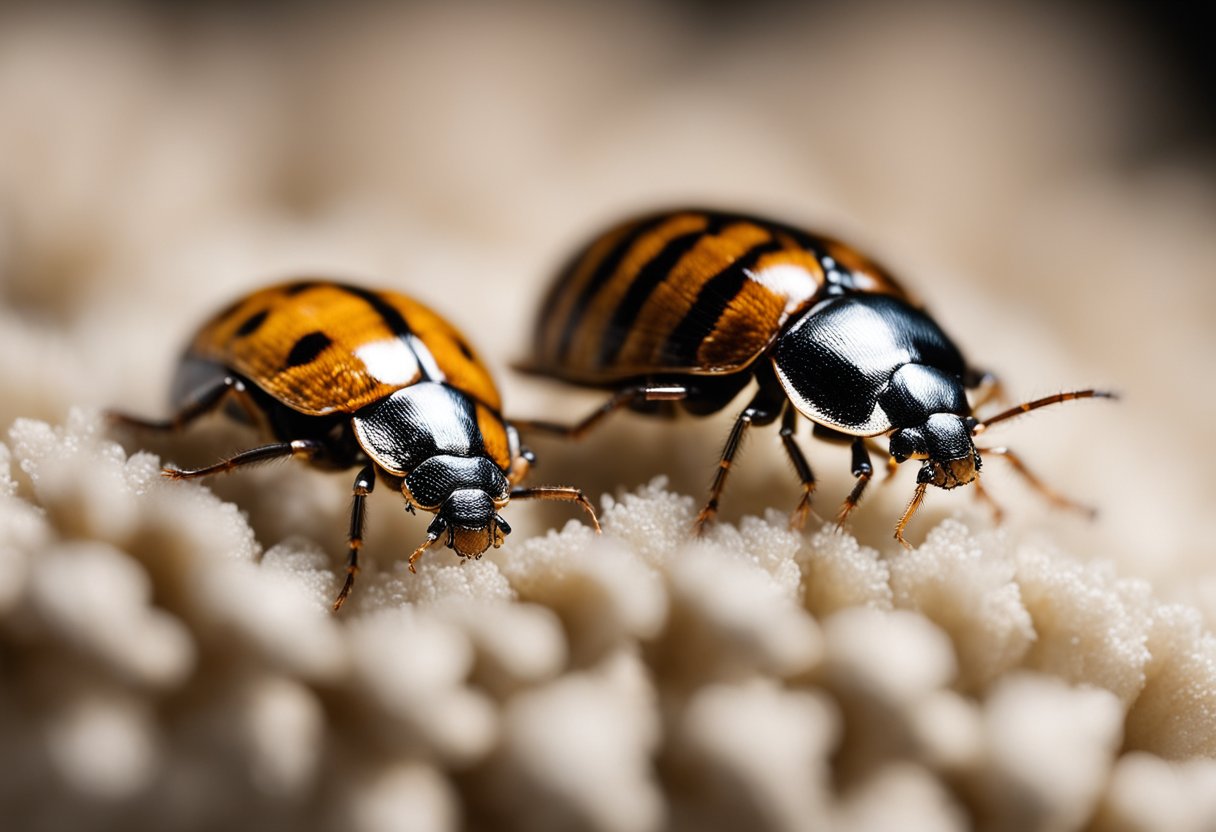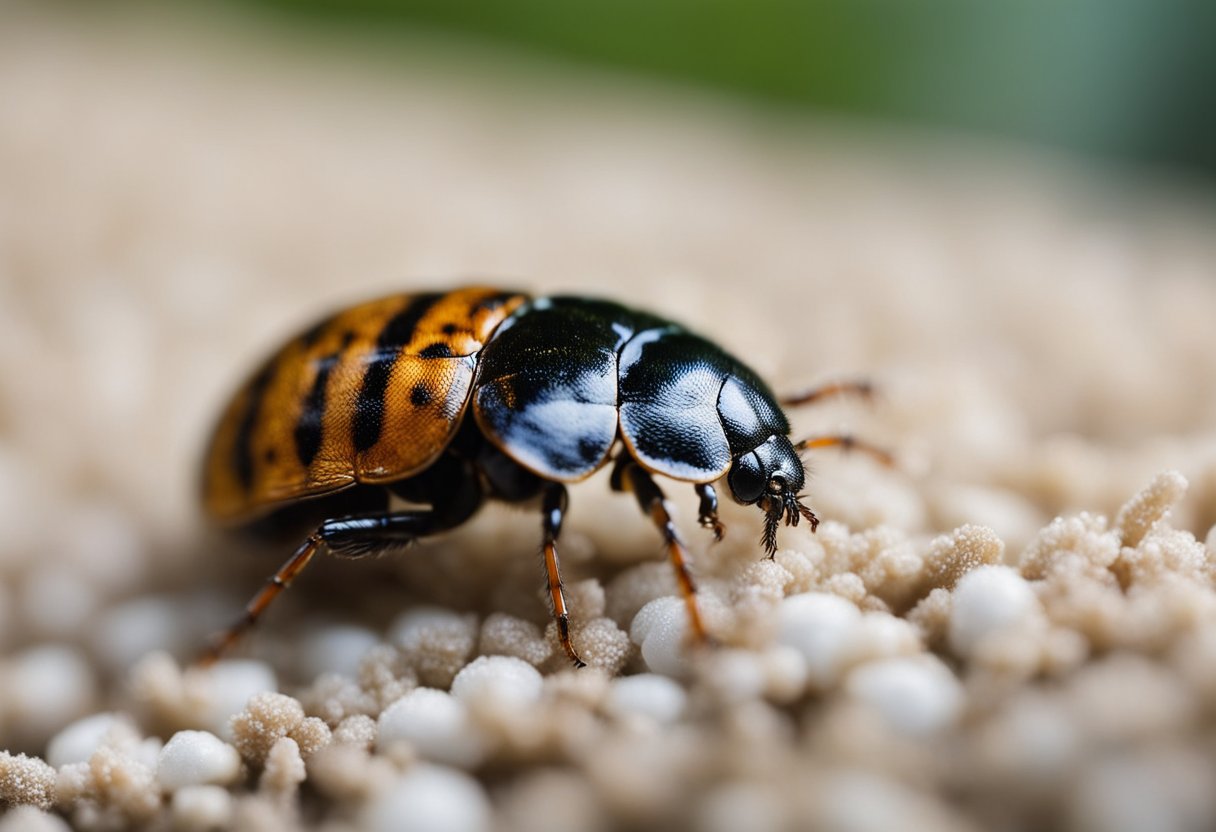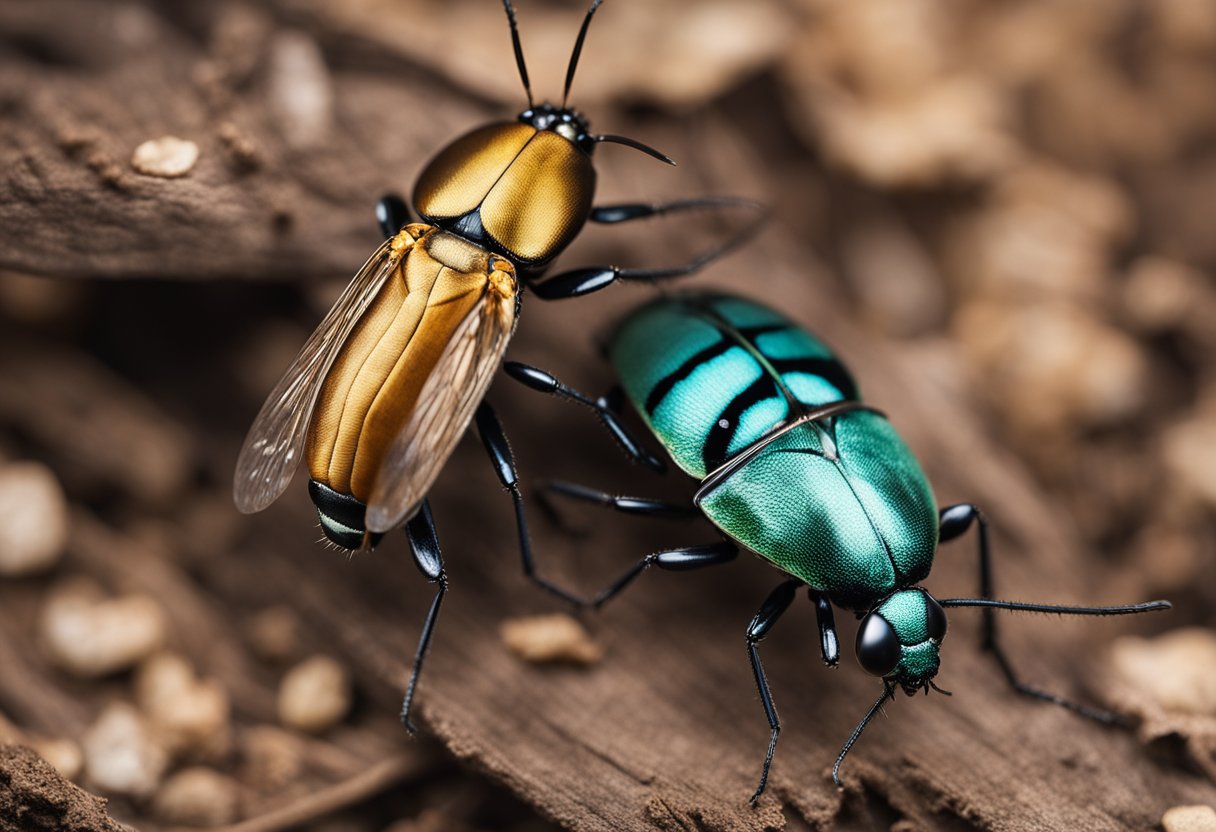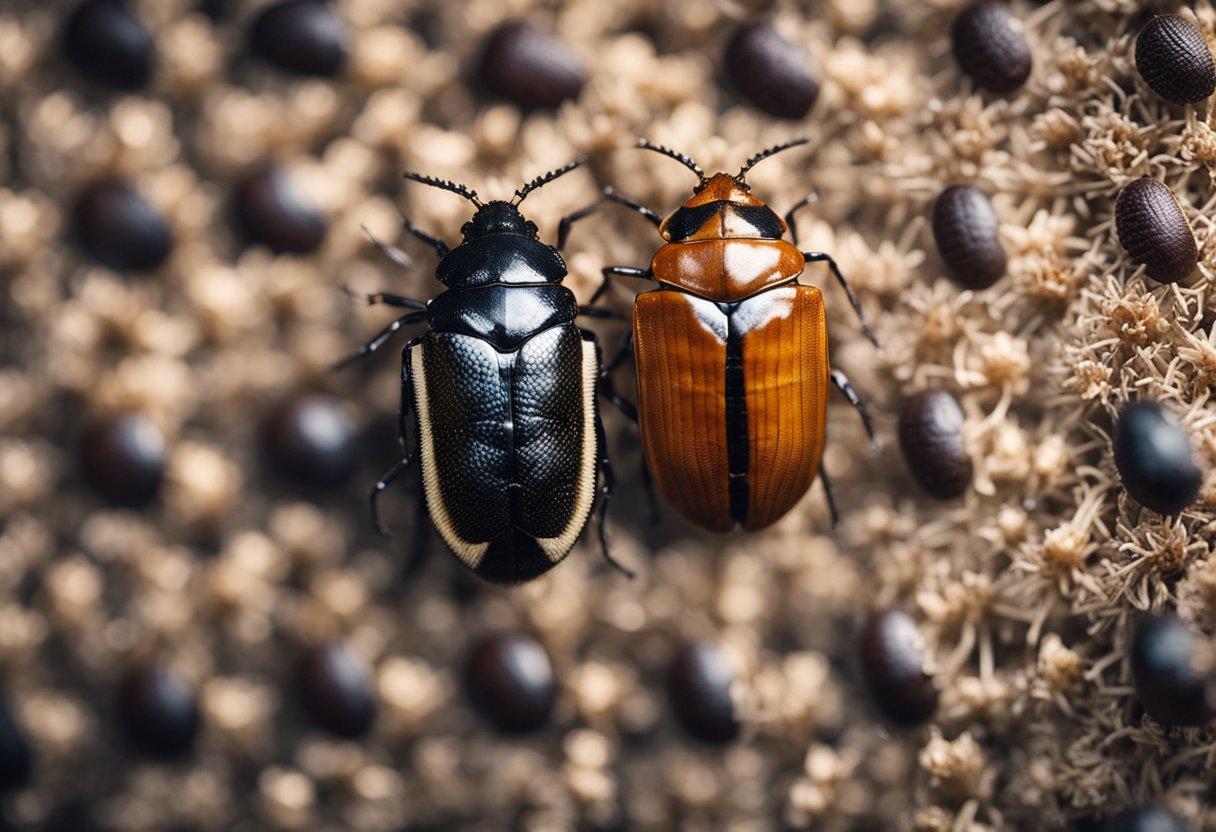Carpet beetles and bed bugs are two common pests that can infest your home and cause damage or discomfort. While both pests are small and can be difficult to spot, there are some key differences between the two that can help you identify which pest you are dealing with.

Carpet beetles are small, oval-shaped insects that are typically less than 1/4 inch in length. They are often found in carpets, rugs, and other fabrics, and can cause damage to these materials over time. Bed bugs, on the other hand, are small, reddish-brown insects that are typically found in bedding, mattresses, and other areas where humans sleep. They feed on blood and can cause itchy, red welts on the skin.
One of the easiest ways to tell the difference between carpet beetles and bed bugs is by their physical appearance. Carpet beetles have speckled shells and are lighter in color with darker spots. The larvae of carpet beetles look like short caterpillars with an elongated body coated with tiny hairs. Bed bugs, on the other hand, are reddish-brown in color and have flat bodies. While both pests can be a nuisance, it is important to correctly identify which pest you are dealing with in order to effectively treat the problem.
Understanding Carpet Beetles

Carpet beetles are a common household pest that can cause damage to carpets, furniture, and clothing. These pests are small, oval-shaped insects that range in size from 1/8 to 1/4 inch in length. There are several species of carpet beetles, but the most common are the varied carpet beetle and the common carpet beetle.
Carpet beetle larvae are the most destructive stage of the insect’s life cycle. They are small, worm-like creatures that feed on natural fibers, including wool, fur, feathers, and silk. They can also feed on synthetic fibers that are blended with natural fibers. Carpet beetle larvae can cause extensive damage to carpets, furniture, and clothing if left unchecked.
Carpet beetles are attracted to light and can often be found near windows. They are also attracted to pollen and can be found in plants and rugs. Black carpet beetles are attracted to fibrous materials and can be found in hidden areas of the home, such as under baseboards or in attics.
To get rid of carpet beetles, it is important to identify the source of the infestation. This may involve inspecting carpets, furniture, and clothing for signs of damage or larvae. It is also important to vacuum regularly and to store clothing and fabrics in airtight containers.
In addition to carpet beetles, there are other pests that can cause damage to carpets, furniture, and clothing, including bed bugs and dermestids. It is important to correctly identify the pest in order to effectively treat the infestation.
Understanding Bed Bugs

Bed bugs are small, reddish-brown insects that are about the size of an apple seed. They are wingless and have flat, oval-shaped bodies that allow them to hide in tight spaces such as cracks, crevices, and seams of mattresses or furniture. Bed bugs are nocturnal, primarily coming out at night to feed on their host’s blood, usually humans.
Bed bug bites can be uncomfortable and irritating, as they often cause itchiness and red bumps on the skin. These bites can be easily mistaken for other skin conditions or insect bites, so it is essential to correctly identify them. Bed bugs typically bite during the night, and you might notice bite marks in a line or cluster on your skin.
If you suspect a bed bug infestation, it is important to inspect your home thoroughly. Look for live bed bugs, shed skins, and blood spots on your bedding or furniture. You can also use bed bug traps or hire a pest control service to inspect your home and identify any infestations.
Getting rid of bed bugs can be a challenging and costly process. It often involves extreme heat treatments or the use of pesticides, which can be harmful to humans and pets. It is important to work with a reputable pest management company that has experience in bed bug removal.
Overall, bed bugs are a common pest infestation that can cause a great deal of stress and discomfort. Proper identification and pest control measures can help to eliminate bed bugs and provide peace of mind for homeowners.
Related Posts:
- How to Check for Bed Bugs: Efficient Detection Methods
- Bed Bug Bites: Effective Prevention and Treatment Methods
- Bed Bugs: Effective Prevention and Treatment Strategies
Comparing Carpet Beetles and Bed Bugs

Carpet beetles and bed bugs are two common pests that can infest homes and cause problems for homeowners. While they may have some similarities, there are also important differences between the two. In this section, we will compare carpet beetles and bed bugs in terms of appearance, behavior, diet, and how to get rid of them.
Appearance
Carpet beetles are small, oval-shaped insects that are typically less than 1/4 inch long. They have a varied appearance, but most species are brown or black with speckled or mottled patterns. Adult carpet beetles have wings, but they are rarely seen flying. The larvae of carpet beetles are elongated and covered in tiny hairs, giving them a fuzzy appearance.
Bed bugs, on the other hand, are reddish-brown in color and have flat, oval-shaped bodies that are about the size of an apple seed. They do not have wings and cannot fly. Bed bug nymphs are smaller and lighter in color than adults, and they may be mistaken for other pests such as fleas or ticks.
Behavior
Carpet beetles and bed bugs have different behaviors. Carpet beetles are attracted to natural fibers such as wool, silk, and cotton, as well as synthetic fibers like polyester and nylon. They may infest carpets, clothing, furniture, and other household items. Carpet beetle larvae feed on a variety of materials, including fibers, pollen, and even dead insects.
Bed bugs, on the other hand, are attracted to human blood and are usually found in areas where people sleep or rest, such as mattresses, box springs, and upholstered furniture. They are nocturnal and usually feed at night, leaving behind itchy welts on the skin. Bed bugs can hitchhike on luggage, clothing, and other items, making them a common problem in hotels and other public places.
Diet
As mentioned earlier, carpet beetles feed on a variety of materials, including fibers, pollen, and dead insects. They are not known to bite humans, but some people may have an allergic reaction to their shed skins or fecal matter.
Bed bugs, on the other hand, feed exclusively on human blood. They use their piercing mouthparts to suck blood from their hosts, leaving behind itchy bite marks. Some people may have an allergic reaction to bed bug bites, which can cause redness, swelling, and itching.
Getting Rid of Them
Getting rid of carpet beetles and bed bugs requires different approaches. For carpet beetles, it is important to identify and remove the source of the infestation, such as an old wool rug or a pile of clothing in the attic. Regular vacuuming and cleaning can also help prevent infestations.
For bed bugs, professional pest control is often necessary. Bed bugs are notoriously difficult to get rid of, and DIY methods such as using insecticides or heat treatments may not be effective. A professional pest control service can provide the equipment and expertise needed to eliminate bed bugs and provide peace of mind.
Differences between Carpet Beetles and Bed Bugs
In summary, carpet beetles and bed bugs are two common household pests that can cause problems for homeowners. While they may have some similarities, such as their small size and oval shape, they have important differences in terms of appearance, behavior, diet, and how to get rid of them. Knowing the differences between carpet beetles and bed bugs can help homeowners identify and address pest infestations quickly and effectively.
Prevention and Control
Prevention is key when it comes to avoiding an infestation of bed bugs or carpet beetles. Regularly cleaning and vacuuming your home can help eliminate any potential hiding spots for these pests. It’s also important to seal any cracks or crevices in your walls, baseboards, or furniture to prevent them from entering your home.
If you suspect an infestation, it’s important to act quickly to prevent the problem from getting worse. Professional pest control services can be expensive, but they can be effective in eliminating the pests. DIY treatments are also available, such as bed bug bombs and sprays, but it’s important to follow the instructions carefully and use caution when applying them.
To get rid of bed bugs, it’s important to wash all bedding and clothing in hot water and dry them on high heat. Vacuuming your mattress and furniture can also help eliminate any eggs or nymphs. Bed bug traps can be an effective way to capture and monitor the pests.
Carpet beetles can be eliminated by cleaning and vacuuming regularly, and storing natural fibers like wool and silk in airtight containers. Insecticides can also be effective in eliminating carpet beetles, but it’s important to read the instructions carefully and use them in a well-ventilated area.
Overall, prevention is key when it comes to avoiding an infestation of bed bugs or carpet beetles. Regular cleaning and sealing any potential entry points can help keep these pests out of your home.
Related Posts:
- Best Bed Bug Bombs: Top Picks for Effective Eradication in 2023
- What Kills Bed Bugs: Effective Solutions for Eradication
- Best Bed Bug Spray 2023: Effective Solutions for Pesky Pests
- Best Bed Bug Traps: A Comprehensive Guide for 2023
Frequently Asked Questions
What causes carpet beetles?
Carpet beetles can be caused by a variety of factors, including poor sanitation, improper storage of food, and the presence of other pests. They are also attracted to natural fibers such as wool, silk, and cotton, which can be found in carpets, clothing, and other household items.
How do I know if I have carpet beetles or bed bugs?
Carpet beetles and bed bugs can be difficult to tell apart, but there are some key differences to look for. Carpet beetles are smaller in size, measuring about 1/8-inch long, while bed bugs are around 1/4-inch long. Additionally, carpet beetles have speckled shells and are lighter in color with darker spots, while bed bugs are reddish-brown in color.
Can a carpet beetle look like a bed bug?
While carpet beetles and bed bugs have some similarities in appearance, they have distinct differences that set them apart. Carpet beetles have a more speckled appearance and are smaller in size, while bed bugs are flat and reddish-brown in color.
Do carpet beetles bite?
Carpet beetles do not bite humans, but they can cause skin irritation in some people. Their larvae can also cause damage to natural fibers in clothing and other household items.
Do carpet beetles get in your bed?
Carpet beetles can get into your bed and other areas of your home, but they do not typically infest bedding like bed bugs do. Instead, they are attracted to natural fibers such as wool, silk, and cotton, which can be found in carpets, clothing, and other household items.
Should I be worried if I see a carpet beetle?
While carpet beetles can cause damage to natural fibers in your home, they are not known to transmit diseases or cause serious health problems. However, if you notice signs of an infestation, such as larvae or damage to household items, it is important to take steps to address the issue.
